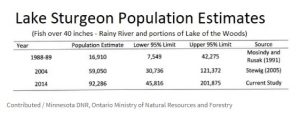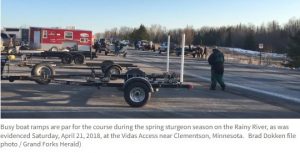
Future of Lake Sturgeon Management Hangs in the Balance as Feds Consider Endangered Species Act Listing
Article by Brad Dokken, Grand Forks Herald
Click Here to Read Brad Dokken’s article on the Grand Forks Herald Website
The upcoming deadline results from a 2018 petition filed by the Center for Biological Diversity requesting that the U.S. Fish and Wildlife Service list lake sturgeon for federal protection.
A looming deadline facing the U.S. Fish and Wildlife Service could have major implications for lake sturgeon management – and anglers who target the prehistoric fish – as the agency decides whether to list the species for federal protection under the Endangered Species Act.
The Service faces a court-ordered deadline of June 30 to decide whether federal protection is warranted.
The upcoming deadline results from a 2018 petition filed by the Center for Biological Diversity requesting that the Fish and Wildlife Service either list lake sturgeon for federal protection throughout its range or as several “Distinct Population Segments” under the Endangered Species Act.
According to the Center, lake sturgeon populations in the Great Lakes and Mississippi River drainage have “declined by roughly 99% over the past century or so.”
In response to that petition, the Service on Aug. 15, 2019, published a 90-day finding in the Federal Register that protection under the Endangered Species Act may be warranted.
The Federal Register is a daily government publication that provides a means for agencies to announce new regulations and proposed changes to existing regulations.
That’s where the upcoming deadline comes into play, said Melissa Clark, public affairs specialist for the U.S. Fish and Wildlife Service’s Midwest Region office in Bloomington, Minnesota.
“To inform the status determination, we are gathering and referencing the best scientific and commercial data available, which includes information regarding states’ management practices for lake sturgeon throughout the range of the species,” Clark told the Herald in an email.
Border country concern
The possibility of listing lake sturgeon for federal protection is especially concerning in the border country, where a healthy sturgeon population on Lake of the Woods and Rainy River is a major tourism draw, especially during the spring “shoulder season” between the end of ice fishing and the mid-May walleye opener.
Nearly wiped out by overfishing and loss of quality spawning habitat in the early part of the 20th century, lake sturgeon populations in both U.S. and Canadian waters of Lake of the Woods and Rainy River were quick to respond to clean water legislation enacted in the late ’60s and early ’70s in both countries.
The population now has met short-term management goals, a benchmark that includes male sturgeon to age 30 and females to age 50, with fish larger than 70 inches present and at least 30 year-classes – fish recruited to the fishery from a given year’s hatch – in the population.
A Border Waters Sturgeon Management Committee that includes representatives from Ontario’s Ministry of Natural Resources and Forestry, the Minnesota DNR and the Rainy River First Nations in Ontario, developed the goals and declared them met in March 2012.
Using a tag-and-recapture sampling technique, project partners in 2014 developed a population estimate of 92,000 lake sturgeon over 40 inches in length on Rainy River and portions of U.S. and Ontario waters of Lake of the Woods, a DNR report shows. That’s up from 59,000 in 2004 and nearly six times the estimate of 16,910 in the late 1980s.

Economic and tourism draw
Because of that rebound, it’s not unusual in late April and early May to see boat ramp parking lots along the Minnesota side of the Rainy River – which otherwise would be empty that time of year – packed with rigs as anglers converge for the opportunity to tangle with fish potentially weighing 100 pounds or more.

The economic impact of that popularity can’t be overstated, said Joe Henry, executive director of Lake of the Woods Tourism.
“Sturgeon fishing has become more and more popular, to the point where some resorts legitimately could go under if sturgeon fishing would go away,” Henry said. “It’s not just the lodging facilities, but for every dollar spent on lodging and in our area, there’s a five to seven times trickle-down effect to the local economy. So, the bait shops, grocery stores, hardware, gasoline, bars, restaurants – everybody would be hurt – because we don’t have people in the area.”
Henry, who recently wrote an opinion piece outlining his concerns about the possible listing, said he’s contacted federal lawmakers, including Rep. Pete Stauber, R-Minn., and Sens. Amy Klobuchar and Tina Smith, both D-Minn., asking them to oppose any potential listing. Stauber also visited the Royal Dutchman Resort on the Rainy River near Baudette, Minnesota, on Wednesday afternoon to hear the owners’ concerns about the potential listing, Henry said.
“I don’t take any of this for granted,” Henry said. “I just think it’s important to be able to be proactive in front of it rather than reactive on the backend.”



